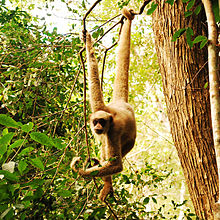Muriqui: Difference between revisions
m r2.7.3) (Robot: Adding vi:Brachyteles |
mNo edit summary |
||
| Line 19: | Line 19: | ||
}} |
}} |
||
The '''muriquis''', also known as '''woolly spider monkeys''', are the [[monkey]]s of the [[genus]] '''''Brachyteles'''''.<ref name=msw3/> They are closely related to both the [[spider monkey]]s and the [[woolly monkey]]s.<ref name=msw3/> The two species are the [[southern muriqui|southern]] (''B. arachnoides'') and [[northern muriqui]] (''B. hypoxanthus'') muriquis.<ref name=msw3/> They are the two largest species of [[New World monkey]]s, and the northern species is one of the most endangered of all the world's monkeys. They are found only in the Atlantic coast forests of southeastern [[Brazil]] at altitudes ranging from sea level to 1500 m (5000 ft). |
The '''muriquis''', also known as '''woolly spider monkeys''', are the [[monkey]]s of the [[genus]] '''''Brachyteles'''''.<ref name=msw3/> They are closely related to both the [[spider monkey]]s and the [[woolly monkey]]s.<ref name=msw3/> The two species are the [[southern muriqui|southern]] (''B. arachnoides'') and [[northern muriqui]] (''B. hypoxanthus'') muriquis.<ref name=msw3/> They are the two largest species of [[New World monkey]]s, and the northern species is one of the most endangered of all the world's monkeys.<ref>{{cite journal|last=Chaves|first=Paulo B.|coauthors=Alvarenga, Clara S.; Possamai, Carla de B.; Dias, Luiz G.; Boubli, Jean P.; Strier, Karen B.; Mendes, Sérgio L.; Fagundes, Valéria|title=Genetic Diversity and Population History of a Critically Endangered Primate, the Northern Muriqui (Brachyteles hypoxanthus)|journal=PLoS ONE|date=3 June 2011|year=2011|volume=6|issue=6|pages=e20722|doi=doi:10.1371/journal.pone.0020722|url=http://www.plosone.org/article/info%3Adoi%2F10.1371%2Fjournal.pone.0020722}}</ref> They are found only in the Atlantic coast forests of southeastern [[Brazil]] at altitudes ranging from sea level to 1500 m (5000 ft). |
||
The adult muriqui is 15-23 inches (38–58 cm) long without its tail and weighs from 10-20 pounds (4.5-9 kilos) It ranges in coloration from brown to black and the underside of their [[prehensile tail]]s has no fur at the end. |
The adult muriqui is 15-23 inches (38–58 cm) long without its tail and weighs from 10-20 pounds (4.5-9 kilos) It ranges in coloration from brown to black and the underside of their [[prehensile tail]]s has no fur at the end. |
||
Revision as of 16:42, 18 February 2013
| Muriquis[1] | |
|---|---|

| |
| Northern muriqui, Brachyteles hypoxanthus | |
| Scientific classification | |
| Kingdom: | |
| Phylum: | |
| Class: | |
| Order: | |
| Family: | |
| Subfamily: | |
| Genus: | Brachyteles Spix, 1823
|
| Type species | |
| Ateles arachnoides É. Geoffroy, 1806
| |
| Species | |
The muriquis, also known as woolly spider monkeys, are the monkeys of the genus Brachyteles.[1] They are closely related to both the spider monkeys and the woolly monkeys.[1] The two species are the southern (B. arachnoides) and northern muriqui (B. hypoxanthus) muriquis.[1] They are the two largest species of New World monkeys, and the northern species is one of the most endangered of all the world's monkeys.[2] They are found only in the Atlantic coast forests of southeastern Brazil at altitudes ranging from sea level to 1500 m (5000 ft).
The adult muriqui is 15-23 inches (38–58 cm) long without its tail and weighs from 10-20 pounds (4.5-9 kilos) It ranges in coloration from brown to black and the underside of their prehensile tails has no fur at the end.
Muriquis are folivores (herbivores), but will also eat significant amounts of fruit and flowers in the rainy season, as well as bark, bamboo, ferns, nectar, pollen, and seeds.
As is common to many platyrrhines, males are philopatric and females tend to move out into other groups at the onset of adolescence around five to seven years of age, later reaching maturity at an average age of 11 years. On average, males reach maturity in half this time.
Observed group sizes range from eight to 43, and contain plentiful numbers of both males and females. Muriquis are polygamous, and unlike many other primates, males spend large periods of time together without significant aggressive encounters. As such, they are also not territorial.
The name "muriqui" comes from a native Tupi word meaning approximately 'largest monkey'. B. arachnoides is also known as mono carvoeiro, which translates to "charcoal monkey".
References
- ^ a b c d Groves, C. P. (2005). "Order Primates". In Wilson, D. E.; Reeder, D. M (eds.). Mammal Species of the World: A Taxonomic and Geographic Reference (3rd ed.). Johns Hopkins University Press. p. 151. ISBN 978-0-8018-8221-0. OCLC 62265494.
- ^ Chaves, Paulo B. (3 June 2011). "Genetic Diversity and Population History of a Critically Endangered Primate, the Northern Muriqui (Brachyteles hypoxanthus)". PLoS ONE. 6 (6): e20722. doi:doi:10.1371/journal.pone.0020722.
{{cite journal}}: Check|doi=value (help); Unknown parameter|coauthors=ignored (|author=suggested) (help)CS1 maint: date and year (link)
External links
- Southern muriqui media from ARKive
- Northern muriqui media from ARKive
- Primate Info Net Brachyteles Factsheet
- Southern Muriqui Home Page - Pró- Muriqui Association
